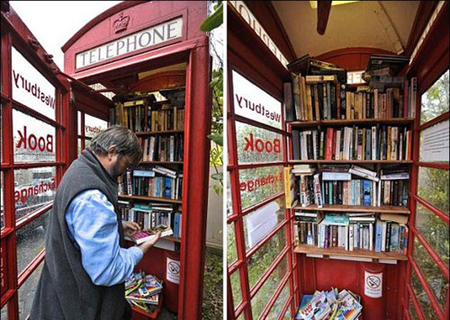 |
|
An image of Britain's red phone box. Britain's iconic red phone boxes have become obsolete in the age of the mobile -- but villages across the country are stepping in to save them, with creative flair.[Agencies] |
|
Britain's iconic red phone boxes have become obsolete in the age of the mobile -- but villages across the country are stepping in to save them, with creative flair. Whether as a place to exhibit art, poetry, or even as a tiny library, hundreds of kiosks have been given a new lease of life by local communities determined to preserve a quintessential part of British life. In Waterperry, a small village near Oxford, the 120 residents have filled the phone box next to the old manor house with a pot of hyacinths, piles of gardening and cooking magazines, and plastered poems on the walls. They took control of the kiosk when telecoms operator BT said it was going to pull it down, an announcement that sparked such uproar that one local woman threatened to chain herself to the box to save it. "I'd have done it," insisted Kendall Turner. "It would have been heartbreaking for the village." Local councillor Tricia Hallam, who came up with the idea for the phone box's makeover, said "quite a few people" would have joined her, adding: "We couldn't let it go because it's a landmark, it's part of our heritage. "We need to keep it here, it's an iconic thing, a British icon." Only three feet by three feet wide, and standing eight foot three inches tall, the kiosks were designed by Giles Gilbert Scott in 1936 for the 25th anniversary of the reign of King George V. Painted in "Post Office red" to match the post boxes, they were once a defining image of England and the backdrop to millions of tourist photographs. Eight years ago there were about 17,000 across Britain, but today, in a country where almost everybody has a mobile phone, 58 percent are no longer profitable and ten percent are only used once a month. (Read by Nelly Min. Nelly Min is a multimedia journalist at the China Daily Web site.) (Agencies) |
在如今的移動(dòng)通訊時(shí)代,英國(guó)標(biāo)志性的紅色電話亭已漸漸過(guò)時(shí),但英國(guó)各地的小鎮(zhèn)居民正發(fā)揮他們的聰明才智來(lái)保衛(wèi)這些“紅盒子”。 紅色公用電話亭被視為英國(guó)社會(huì)的文化標(biāo)志,在社區(qū)居民的努力下,英國(guó)數(shù)百個(gè)電話亭獲得新生,被用來(lái)展示藝術(shù)、詩(shī)歌,甚至變身為迷你圖書(shū)館。 在牛津郡附近的沃特佩里小鎮(zhèn),120名居民在一個(gè)緊挨著一處古老的領(lǐng)主宅邸的電話亭里放上了一盆風(fēng)信子、幾疊園藝及廚藝雜志,并在亭壁上貼了一些詩(shī)作。 這座電話亭曾險(xiǎn)些被英國(guó)電信公司拆毀,但當(dāng)?shù)鼐用駥⑵渫炀攘讼聛?lái)。當(dāng)時(shí)電信公司要拆除電話亭的消息引發(fā)了民眾的強(qiáng)烈不滿(mǎn),當(dāng)?shù)匾幻麐D女還威脅要把自己和電話亭拴在一起來(lái)保衛(wèi)它。 肯德?tīng)?特納堅(jiān)稱(chēng):“要是我也會(huì)那樣做。拆除電話亭會(huì)讓小鎮(zhèn)居民們很傷心。” 想到改造電話亭這一辦法的當(dāng)?shù)刈h員特里希婭?哈勒姆說(shuō),(如果要拆毀的話,)會(huì)“有很多人”加入到保衛(wèi)電話亭的隊(duì)伍。她說(shuō):“我們不能就讓它這么沒(méi)了,因?yàn)樗俏覀兊牡貥?biāo),是我們的遺產(chǎn)之一。” “我們要把它留在這里,它是一種標(biāo)志,是英國(guó)的標(biāo)志。” 英國(guó)的紅色電話亭長(zhǎng)寬各只有3英尺,高為8英尺3英寸,是1936年加爾斯·吉爾伯特·斯哥特為紀(jì)念國(guó)王喬治五世統(tǒng)治25周年而設(shè)計(jì)的。 電話亭的顏色為“郵政紅”,與英國(guó)郵政信箱的顏色相一致。這些紅色電話亭曾是英國(guó)的標(biāo)志性形象,也是游客們爭(zhēng)相留影的街頭一景。 八年前,英國(guó)全國(guó)共有約1.7萬(wàn)個(gè)電話亭,但如今英國(guó)幾乎人手一部手機(jī),58%的電話亭已不再盈利,其中10%的電話亭一個(gè)月才被使用一次。 相關(guān)閱讀 英國(guó)擬現(xiàn)金獎(jiǎng)勵(lì)器官捐獻(xiàn) 調(diào)查:85%英國(guó)人稱(chēng)自己“盲目進(jìn)食” 英國(guó):推特用戶(hù)創(chuàng)作新版莎翁名著 英國(guó)人家裝DIY興趣減退 省下時(shí)間去旅游 (中國(guó)日?qǐng)?bào)網(wǎng)英語(yǔ)點(diǎn)津 Julie 編輯蔡姍姍) |
|
Vocabulary: kiosk:公用電話亭 a new lease of life:新生 quintessential:representing the perfect example of a class or quality(精粹的,精髓的) plaster on:在上面涂抹或粘貼 |
